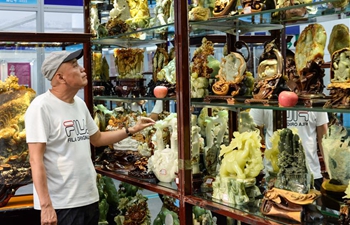GUANGZHOU, July 18 (Xinhua) -- Using artificial intelligence (AI) technologies, Chinese researchers have developed a rapid and accurate screening model to diagnose cervical cancer, a common and fatal disease in women.
Cervical cancer, caused by the human papilloma virus (HPV), is the fourth most frequent cancer in women worldwide, with an estimated 570,000 new cases reported and 311,000 deaths from the disease in 2018, according to the World Health Organization.
In China, the incidence and death rates of cervical cancer are also high, with 130,000 new cases reported last year. Most cases are caused by delayed checks.
The current method to detect abnormal cervical cells is cytology-based screening, known as the Pap test. It is often done during a pelvic examination which allows the health care professional to have a clear view of the cervix and upper vagina by a speculum and take a sample of cervical cells.
Based on more than 200,000 pathological images selected from over 43.5 million cervical screening samples, experts from KingMed Diagnostics, a Guangzhou-based medical diagnostic testing company, along with computer engineers from Huawei Cloud, a subsidiary of the Chinese tech giant Huawei, over one year developed an AI-assisted screening model, which can diagnose the disease with an accuracy of over 99 percent, while costing only one-tenth of the examination time performed by pathologists.
"Pathologists spend an average of six minutes in examining a cervical screening sample under a microscope, while the AI model just needs 36 seconds per case," said Luo Pifu, director of the company's pathological department and lead researcher of the program.
Cervical cancer can often be detected early, and sometimes even prevented entirely, by having regular screenings. More than 350 million Chinese women aged 30 to 65 need cervical cancer check-ups every three to five years, but the country still lacks the screening capacity to meet the demand.
Data from the National Health Commission shows that China offered free cervical cancer checks to 85 million rural women from 2009 to 2018, to promote screening in impoverished areas.
In addition, a report last year by state television broadcaster CCTV shows that China currently has about 10,000 licensed pathologists but still requires at least a further 90,000.
The talent shortage has limited the promotion of cervical cancer screening, according to Li Yinghua, chief information officer of KingMed Diagnostics.
The company expects the AI-assisted screening to help offset the shortage of well-trained pathologists, as well as expand the scope of early examination of cervical cancer in China.
In 2018, KingMed and Huawei agreed to cooperate in building an AI model for cervical cancer screening.
Compared with AI models using CT or MRI images, the AI-assisted screening model for pathology is more complicated, as pathological images are richer in color, larger in size, and require higher precision so that doctors can see the abnormality of cells, said Luo.
Many cancer patients have to take pathological examinations to know whether their tumors are malignant or benign. Pathological images are an important basis for doctors to make treatment plans.
To train, validate and test the AI, developers fed it with 32,000 samples collected by the company from six provinces in the past 12 years.
The AI was built on the basis of ModelArts, an AI development platform developed by Huawei Cloud which turned the diagnostic experiences accumulated by experts into algorithms and models.
With technologies such as data annotation, model training, image classification and case-based reasoning, the AI can automatically complete the diagnosis procedure, while the pathologists only need to review and confirm the positive cases, said Tu Dandan, a senior technical director of the Huawei Cloud.
Results showed that the model can diagnose the disease with a true positive rate of over 99.9 percent, and a negative predictive value of more than 99 percent, according to the diagnostics company.
The two companies will continue cooperation to explore more possible applications of the AI technologies in the field of pathology, such as breast, digestive system, kidney and blood diseases.
"We believe the AI-assisted screening model can save a great deal of manual labor and expand screening coverage, which will benefit more people," said Luo.

















